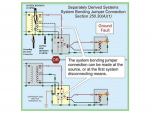- Location
- Lockport, IL
- Occupation
- Retired Electrical Engineer
I continue to be confused by the notion of a Supply Side Bonding Jumper (SSBJ). Here's my current conundrum: Do I have any of this right?
- Utility transformer.
- Main panel (MDP) in main electrical room has N-G bond.
- Secondary conduits are PVC.
- SSBJ, sized per 250.102(C) is run with the secondary A, B, C, N.
- SSBJ is bonded to both the transformer enclosure and the MDP enclosure (not sure exactly where).
- In order to prevent parallel current flowing in both the secondary N and the SSBJ, the bonding strap between the transformer's N point and its enclosure must be removed.


